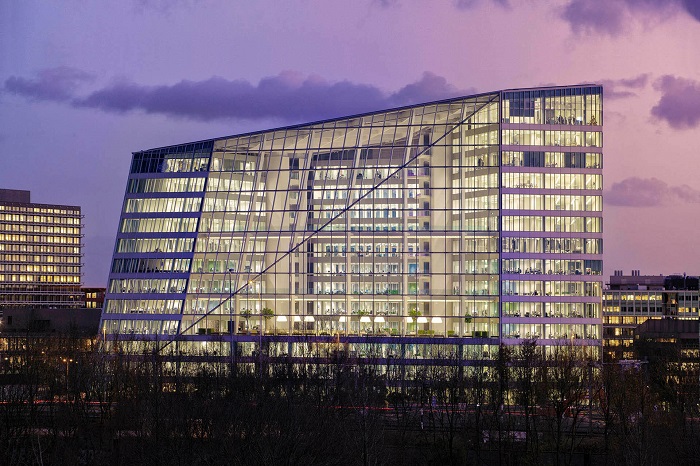ISABEL RUBIO ARROYO | Tungsteno
Carbon dioxide emissions from buildings and construction reached a new high in 2021, according to the UN’s 2022 Global Status Report for Buildings and Construction. The sector accounts for more than 34% of energy demand and around 37% of energy- and process-related CO2 emissions globally. Building sustainably and reducing the environmental footprint of structures is one of the great challenges of the century. We take a look at the operation of three buildings that generate more energy than they consume.
Powerhouse Brattørkaia
The Powerhouse Brattørkaia office building in Trondheim, Norway, produces more than twice as much electricity as it consumes daily. It generates about 500,000 kilowatt hours (kWh) of electricity over a year and, according to its creators, "functions as a small power plant in the middle of the city." It not only supplies renewable energy to itself, but also shares it with neighbouring buildings, electric buses, cars and boats through a local microgrid.
Snøhetta, the Norwegian architecture firm that designed the building, boasts that it "produces more energy than it consumes over its lifespan, including construction, demolition, and the embodied energy in the materials used to construct it." The goal of Powerhouse Brattørkaia is threefold: "to maximise the amount of clean energy produced by the building, to minimise the energy required to run it, and to serve as a pleasant space for its tenants and the public."
It was built between 2012 and 2019 and its location was chosen to ensure maximum sun exposure throughout the day and seasons, minimising the use of artificial light. This is important given that it is equipped with almost 3,000 square metres of solar panels and has a container nearby to store energy to supply the microgrid. It also uses a sophisticated ventilation system, energy-efficient electrical appliances and seawater for heating and cooling.
Powerhouse Brattørkaia shares the energy it generates with other buildings and vehicles. Credit: Snøhetta
Freiburg Town Hall
The Town Hall of Freiburg, a university town in south-west Germany, is the world’s first public building to generate more energy than it consumes and feed it back into the local grid. In addition to integrating 880 photovoltaic modules into the façade, which is designed for good thermal insulation, the structure has a system that monitors and optimises the building's energy performance.
"The primary energy demand of the town hall for heating, cooling, ventilation, and hot water supply is as low as 55 kilowatt hours per square meter per year—which is only 40 percent of the primary energy demand of comparable modern office buildings," says ingenhoven architects, who designed the building.
The 24,215 square metre building houses offices, conference rooms and restaurants for 840 local government employees. The town hall draws its heating and cooling from an underground water well. To heat the building, this well is connected to two heat pumps. According to a report on the building, "pleasant temperatures in summer are ensured by groundwater cooling, without the aid of heat pumps."
Freiburg Town Hall generates more energy than it consumes thanks to 880 photovoltaic modules. Credit: ingenhoven architects
The Edge
The Edge, a 40,000 square metre building in Amsterdam designed for its main tenant, Deloitte, uses 70% less electricity than comparable office buildings, according to the Building Research Establishment (BRE). It is one of the greenest buildings in the world, as recognised by the international sustainable building certification BREEAM, and can generate more energy than it produces.
The roof and one of its facades "incorporate the largest array of photovoltaic panels of any European office building"—some 6,038 square metres. The Edge's heating and cooling is sustainably regulated, according to the BRE. The building has two underground water sources that are located 130 metres below ground: one for cold water and one for warm water. "These so-called aquifer thermal energy storage pumps, depending on the inner and outer climate, pump warm or cold water into or out of the building," explains the BRE.
This building is also one of the smartest on the planet. It knows where each employee lives, which car they drive and who they will meet each day. Employees have an app that keeps them connected from the moment they wake up and has all the information about their schedule. With its 28,000 sensors, the building recognises when cars arrive and directs them to a specific parking space.
The Edge is one of the world’s smartest and greenest buildings. Credit: PLP Architecture
In the context of climate change, all these buildings share the goal of reducing dependence on fossil fuels and greenhouse gas emissions. "Involving the entire value chain from day one is probably the only way to achieve such an ambitious goal. In addition to the contractor, building owner and architect, you also need to have consultants in electrical, water and plumbing systems on board from the start," says Rune Grasdal, Senior Architect at Snøhetta. By making a building highly energy efficient throughout its lifecycle and generating more energy than it consumes, another important challenge is met: providing renewable energy to the surrounding community.
· — —
Tungsteno is a journalism laboratory to scan the essence of innovation.
